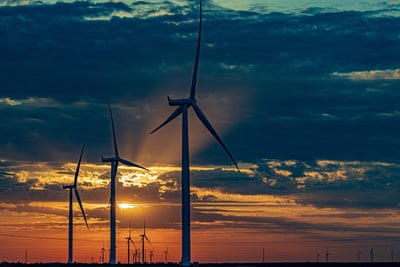
We’ve all been told Chicago is “The Windy City,” but is it the gustiest locale in the United States? It turns out that despite the reputation, Chicago is not, in fact, the windiest US city. It doesn’t even crack the top ten, with an annual average wind speed of only 9.9 mph!
So, where must you go to find the most reliably breezy weather? This article will explore the eleven windiest cities in the US with a population above 25,000 as of the 2021 census.
While Chicago’s 9.9 mph annual average wind speed isn’t impressive enough to earn it a spot among the windiest places in America, it is above the median national wind speed value of 8.2 mph. None of these numbers sound especially impressive. After all, who could tell the difference between an 8.2 mph wind and one blowing at 9.9 mph? But remember: these are averages throughout the year, including all those muggy summer nights with hardly a single puff of wind in the air.
Do Tornadoes Affect the Data and the Rankings?
To earn a spot on this list, a city must not only be exposed to extreme wind events such as tornadoes, severe thunderstorms, hurricanes, or blizzards but also be consistently windy. This also explains why these rankings aren’t entirely dominated by cities in tornado alley (often considered the Great Plains into parts of the Deep South).
Tornadoes produce the most extreme winds known to exist on planet Earth. But they are small, brief, and extremely difficult to measure. Only a handful of weather stations have even been struck by a tornado, and almost none of them have survived. Even if they did survive, a tornado’s peak winds last only a few seconds to perhaps a minute or two. That’s enough time to do severe damage but not nearly enough to sway long-term averages meaningfully.
Similarly, while hurricanes last a bit longer than tornadoes and are considerably larger, their region of peak winds is still quite small and only lasts for an hour or maybe two. This list is all about consistency. This list includes the cities that can experience extreme winds from time to time but also remain at least somewhat breezy day after day for most of the year.
What Is the Windiest City in the United States?
Let’s take a look at the windiest places in the United States, according to the average wind speed data from NOAA’s National Centers for Environmental Information (NCEI).
1. Dodge City, Kansas

- Average Wind Speed: 13.1 mph
- Average Windiest Month: April
- Average Calmest Month: August
- Record Wind Gust: 84 mph on December 15, 2021
With an average wind speed of 13.1 mph, Dodge City, Kansas, is the windiest city in the US, with a population of more than 25,000 permanent residents as of the 2021 census.
It sits squarely in the middle of the country’s windiest terrain: the Southern Plains. A few factors cause such strong winds here. First, the wide open country with few obstructions (trees, buildings, mountains, etc.) helps wind pick up and retain more momentum than over forested or mountainous terrain with higher friction.
The Great Plains is also the site of a meteorological phenomenon known as the Nocturnal Low-Level Jet. Most powerful in the springtime, this current of fast-moving air near the surface is caused by differences in temperature that occur over the broadly-sloping topography of the plains each night. Temperatures fall faster over the higher, drier Western Plains compared to the lower, more moisture-rich Eastern Plains. This temperature difference is associated with a pressure gradient that produces strong southerly winds each night. While the strongest winds associated with this feature are usually found about 3-5,000 feet above the ground, plenty of those gusts make it to the surface.
Thanks to the low-level jet, which peaks during the springtime, March, April, and May are the windiest months in Dodge City, with average speeds exceeding 14 mph. Calmer conditions settle in during the late summer (August is the calmest month, with average wind speeds of just over 11 mph).
Dodge City can also experience powerful winds descending off the Rocky Mountains during the winter. This is the type of event that produced Dodge City’s record wind gust of 84 mph on December 15, 2021.
2. Amarillo, Texas
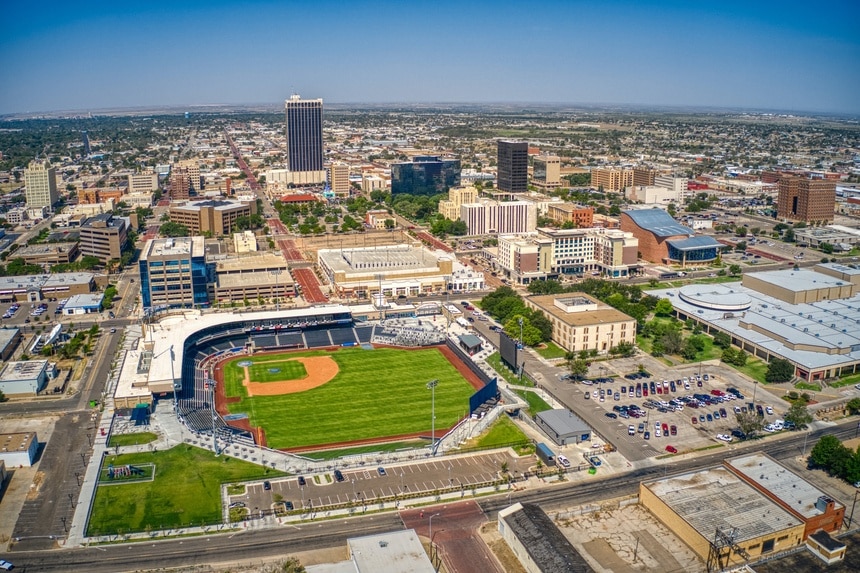
- Average Wind Speed: 12.9 mph
- Average Windiest Month: April
- Average Calmest Month: August
- Record Wind Gust: 84 mph on May 15, 1949
Much like Dodge City—Amarillo, Texas, experiences strong winds thanks in large part due to the open terrain of the Western Plains. It, too, benefits from the low-level jet discussed above, but its location farther south and west means that it can tap into another feature for reliably-gusty springtime wind: the dryline.
The dryline is a boundary separating warm, moisture-rich air originating in the Gulf of Mexico from hot, bone-dry air originating over the high desert of northern Mexico and the southwestern United States. Each afternoon in the spring, as the sun beats down on the arid terrain of western Texas, the dry air surges out of the desert across the plains, leading to strong southwesterly winds.
Because this phenomenon relies on strong sunshine and, to a lesser extent, the proximity of the energetic upper-level jet stream, winds are strongest in Amarillo, Texas, during the spring. Unlike Dodge City, April is clearly the windiest month in Amarillo and is the only month with an average wind speed above 14 mph.
Amarillo, Texas, also sits in the heart of Tornado Alley, and it was a weak tornado passing near the station that produced its record wind gust of 84 mph on May 15, 1949.
3. Kahului, Hawaii
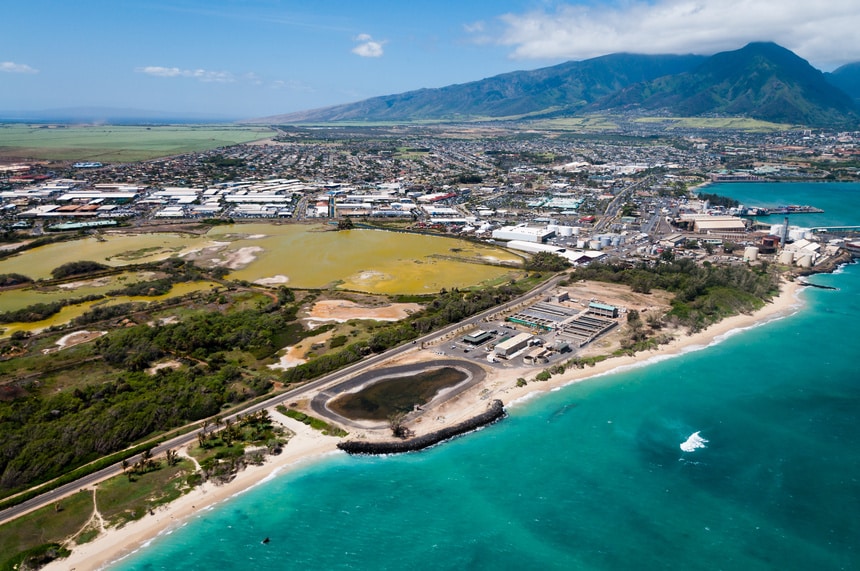
- Average Wind Speed: 12.8 mph
- Average Windiest Month on Average: July
- Average Calmest Month: January
- Record Wind Gust: 54 mph on January 27, 1991
Far from the Southern Plains, Kahului, Hawaii, cruises into the number three spot on the back of consistent trade winds. Trade winds are the name given to the band of east-northeasterly winds that circle the globe just north and south of the equator. They are called trade winds because they were used to facilitate trade networks back when sailing ships were the primary means of transporting goods around the world.
Trade winds are strongest in the summer when vast bubbles of warm high pressure dominate the subtropics, leading to a contrast with lower-pressure air near the equator. Thus July is the windiest month in Kahului, with the highest average wind speed of 15.3 mph, and June is only barely in second place at 15.2 mph.
While Hawaii is usually safe from intense storms, some do impact the island during the winter. During these storms, Kahului is vulnerable to strong southerly wind gusts blowing down the northern slopes of the Haleakalā volcano. One of these events on January 27, 1991, caused Kahului’s record wind gust of 54 mph. Kahului is also one of the hottest cities in the US, with an average annual temperature of 75.8°F.
4. Cheyenne, Wyoming
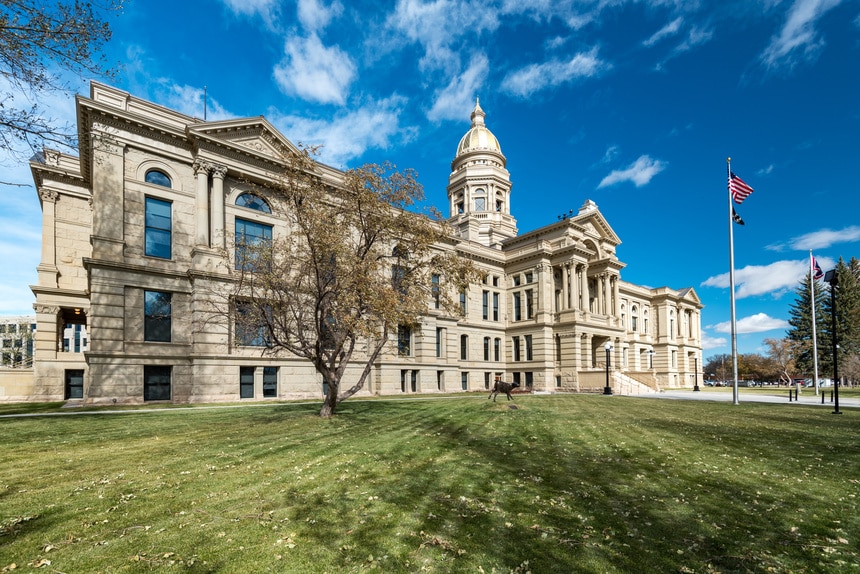
- Average Wind Speed: 12.2 mph
- Windiest Month: January
- Calmest Month: August
- Record Wind Gust: 86 mph (Date Unknown)
Sitting in the open country east of Wyoming’s Snowy Mountains, Cheyenne is ideally positioned for strong winds, especially during the winter. When strong Pacific storms slam into the Rocky Mountains, their intense winds can be directed downwards towards the surface if the wind direction is perpendicular to the orientation of the mountain range.
Prevailing wintertime winds in Wyoming are from the west, and the Snowy Mountains west of Cheyenne run north to south, making it an ideal candidate for strong windstorms. These storms are usually most intense in January when average wind speeds in Cheyenne exceed 14 mph, but they can happen any time during the winter. Summer is the calmest season in Cheyenne, with average wind speeds staying below 10 mph in July and August.
5. Casper, Wyoming

- Average Wind Speed: 12.0 mph
- Average Windiest Month: January
- Average Calmest Month: July
- Record Wind Gust: 78 mph (Date Unknown)
Located just 140 miles north-northwest of Cheyenne, Casper also enjoys relatively open terrain and proximity to the wintertime storm track. Casper also sits downwind of a prominent mountain range, the Wind Rivers, though they’re a bit farther away than Cheyenne’s Snowys. As a result, Casper doesn’t quite get the same level of intense wind at the same frequency. Much like Cheyenne, Casper’s calmest time is mid to late summer. Surprisingly, Casper also earns a spot in our list of the snowiest cities in the US.
6. Rochester, Minnesota
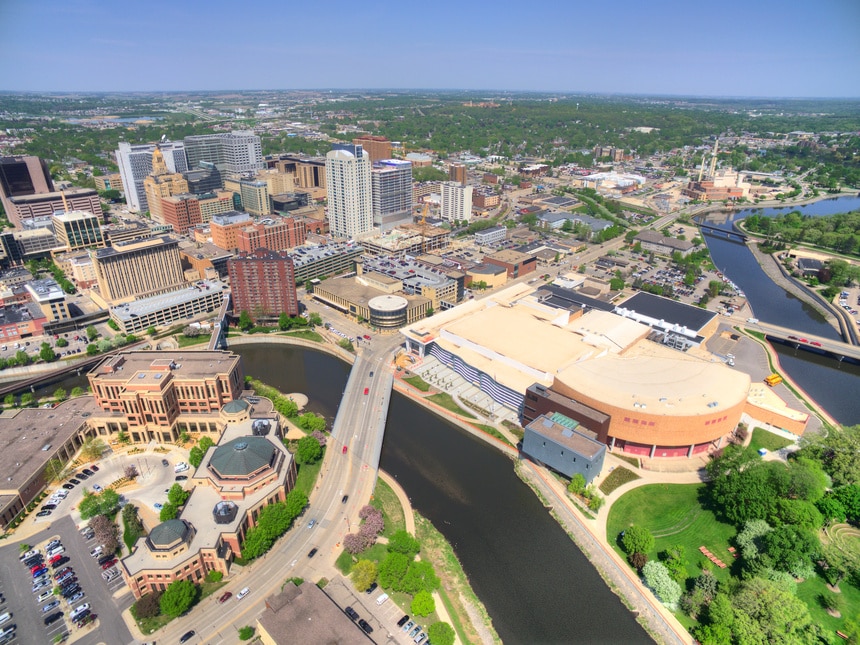
- Average Wind Speed: 12.0 mph
- Average Windiest Month: January
- Average Calmest Month: August
- Record Wind Gust: 74 mph on July 20, 2019
Back on the Plains, Rochester, Minnesota, beats out nearby Minneapolis and Chicago to claim the number six spot. Much like Dodge City, Kansas, Rochester benefits from the nocturnal low-level jet in the spring, though it is too far east to see the strongest effects. Instead, Rochester’s breeziest month is January, when bitter cold northwest winds sweep down from Canada, followed shortly by warm southwesterly breezes as storms move off the Rockies.
On average, Rochester’s calmest months are July and August, but during this time, they are prone to extreme (albeit brief) windstorms known as derechos. A derecho is a long-lived, well-organized cluster of thunderstorms that produces a continuous path of damaging winds. Derechos are relatively rare in any given place, but the upper Midwest is where they are most commonly found each summer. On July 20, 2019, a derecho was responsible for Rochester’s strongest wind gust of 74 mph.
7. Lubbock, Texas
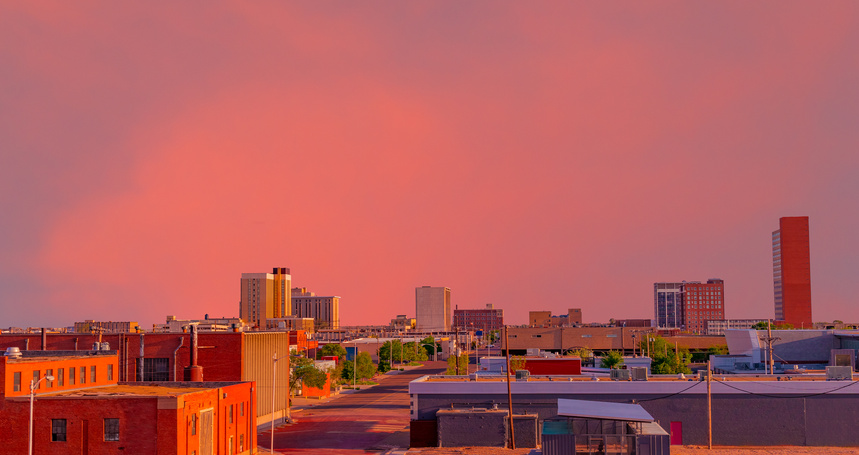
- Average Wind Speed: 12.0 mph
- Average Windiest Month: April
- Average Calmest Month: August
- Record Wind Gust: 90 mph on May 9, 1952
Located just 100 miles south of Amarillo, Texas, Lubbock shares all of the qualities that earned the former location a spot in the rankings. It’s a wide-open country occupied mostly by cattle ranches and oil wells, letting winds keep up their speed with little obstruction. Unique springtime weather patterns lead to strong winds both during the day from the dryline and at night due to the low-level jet stream. April is Lubbock’s windiest month, with the highest average wind speed of 14.3 mph, while August is the calmest month, with an average wind speed of 10.0 mph.
8. Corpus Christi, Texas

- Average Wind Speed: 11.7 mph
- Average Windiest Month: April
- Average Calmest Month: September
- Record Wind Gust: 161 mph during Hurricane Celia on August 3, 1970
Far from mountains or open plains, Corpus Christi takes a very different path to the top ten. While the city is occasionally prone to extreme winds from hurricanes (it notched an impressive 161 mph gust during Celia in 1970), such intense storms are infrequent in the city. Instead, Corpus Christi earns its spot in the top ten by keeping things consistent. In the spring, the dryline and low-level jet funnel warm Gulf air north and give the city consistent south-to-south-easterly breezes.
In the summer, sea breezes kick up off the Gulf each afternoon as interior Texas bakes under intense sun. In the fall and winter, the storm track edges closer, and winds can pick up from the west or even northwest. April takes a slight edge for the windiest month, but the rest of the year is remarkably consistent, with average winds hovering around 10-12 mph.
9. Wichita, Kansas
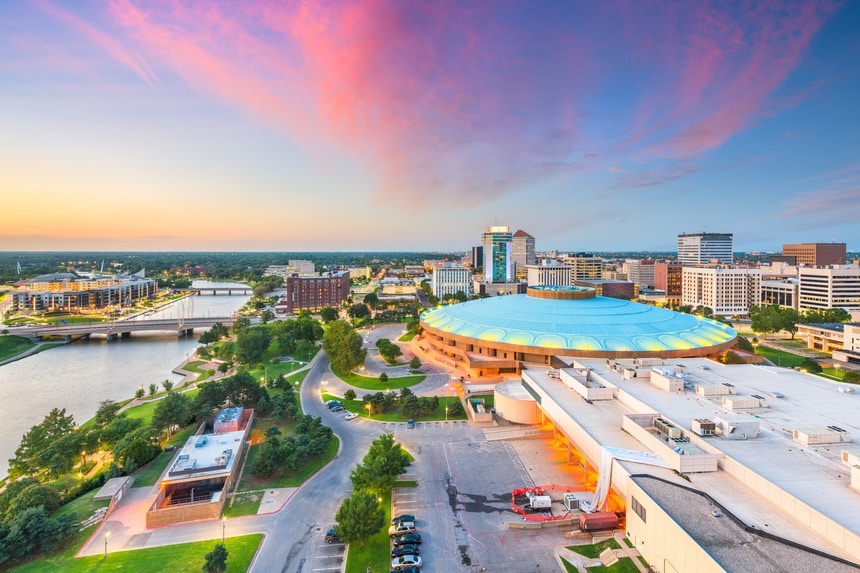
- Average Wind Speed: 11.5 mph
- Average Windiest Month: April
- Average Calmest Month: August
- Record Wind Gust: 101 mph on July 11, 1993
Not far from Dodge City, Wichita, Kansas, follows the same playbook to earn a spot in the rankings. Spring is the windiest season, thanks to the low-level jet, while winds settle down somewhat in late summer. Vast open farmland with little friction also plays a vital role in keeping air moving quickly to its destination.
Like any town or city in the central United States, Wichita is occasionally prone to extreme thunderstorm winds during the warmer months. One such severe thunderstorm in July 1993 produced the city’s strongest recorded wind gust of 101 mph.
10. Great Falls, Montana
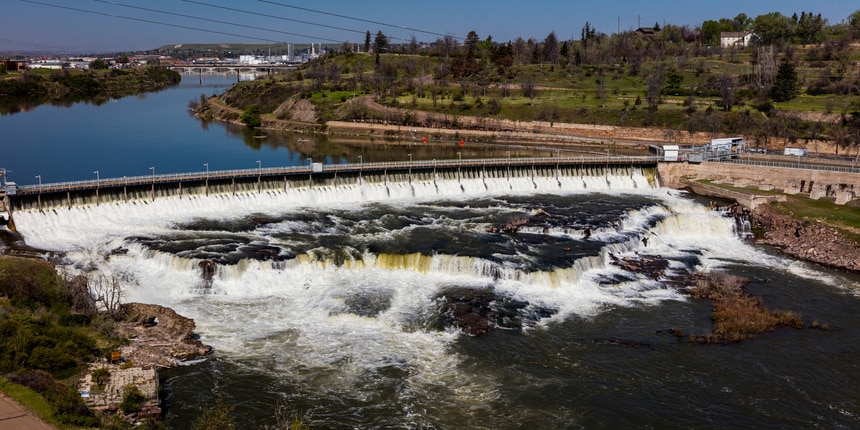
- Average Wind Speed: 11.5 mph
- Average Windiest Month: January
- Average Calmest Month: July and August
- Record Wind Gust: 85 mph (Date Unknown)
Located just north of one major mountain range and just east of another, Great Falls follows Wyoming’s path into the top ten. Its winter windstorms are famous for coming alongside wild temperature fluctuations. Some of the most rapid temperature changes in the world have been recorded near Great Falls as shallow Arctic air masses that come down from Canada with sub-zero temperatures can get chewed up in a matter of hours by strong gusts coming over the Rockies.
June, July, and August are all similarly tranquil in Great Falls as high pressure takes over, and any jet stream winds that might usually roar down the mountain slopes get pushed north into Canada and weaken considerably.
11. Boston, Massachusetts

- Average Wind Speed: 11.5 mph
- Average Windiest Month: March
- Average Calmest Month: August
- Record Wind Gust: 90 mph on October 17, 2019
Boston, Massachusetts, rounds out our list thanks to a mix of consistent summertime sea breezes off the cold Gulf of Maine and strong winter storms, commonly known as nor’easters. Nor’easters are a fixture of fall, winter, and early spring along the East Coast. They form when cold Canadian air moving across the Great Plains collides with the warm Gulf Stream waters off the East Coast. This collision fuels the development of intense storms that bring heavy rain, snow, and, most notably, strong winds out of the northeast as they move toward Atlantic Canada.
Some of Boston’s strongest wind gusts come not from the northeast but from the southeast, during events locals call “sou’easters.” These intense storms are most common in the fall and early winter when the (relatively) warmer waters help strong winds aloft make it to the surface. One of these intense sou’easter events brought Boston its strongest wind gust on October 17, 2019.
What is the Highest Wind Speed Ever Recorded in the United States?
Mount Washington, New Hampshire, takes the cake easily for the highest wind speed ever recorded in the United States, with a reading of 231 mph on April 12, 1934, as a strong storm moved just west of the peak.
For a while, this was the strongest recorded wind gust in the world! However, an automated weather station on Barrow Island in Australia measured a 253 mph gust on April 10, 1996, during an intense tropical cyclone (what folks in the Southern Hemisphere call a hurricane). Thus Mount Washington can only claim to have the fastest wind gust directly observed by a human.
Mount Washington is by far the windiest weather station in the United States, with an annual average wind speed of 35.8 mph which is more than double the value of the windiest city on our list! However, Mount Washington doesn’t earn a spot in the rankings because it has no permanent residents. A rotating team of scientists keeps watch at the summit and maintains the weather station.
Why is Chicago Called “The Windy City”?
So, why is Chicago called “The Windy City” if that title should belong somewhere else? There doesn’t seem to be any definitive account, and some historians still disagree about its origin. One important factor appears to have been the city’s effort to market itself as a summertime tourist destination for those seeking a respite from the sweltering summer heat. In the summer, the Great Plains around Chicago can become extremely hot. Thankfully for Chicago residents, the cool water of Lake Michigan kicks up a lake breeze that often brings relief to the city. Another factor may have been Chicago’s reputation for bragging about its grandeur and rival Midwest cities poking fun at its residents and politicians for being “full of hot air.”
Final Thoughts
Overall, locations among the Great Plains and the leeward (eastern, downwind) side of the prominent Rocky Mountain subranges dominate the windiest city rankings. This is due to a few different reasons, including the wide open, low-friction terrain in that part of the country, along with unique meteorological features such as the nocturnal low-level jet, dryline, and interactions with the wintertime jet stream. That said, high winds are not confined to the nation’s midsection. Cities in Hawaii, the Gulf Coast, and New England have earned spots in the rankings due to their region’s unique weather.
This list is compiled using data from the NOAA’s National Centers for Environmental Information Comparative Climatic Dataset. This dataset uses information spanning from the late 1940s or early 1950s (depending on the station) until 2020, ensuring a long period of reliable data to make comparisons. Wind gust data has been retrieved from National Weather Service Record Event Reports when available or from local news articles.




